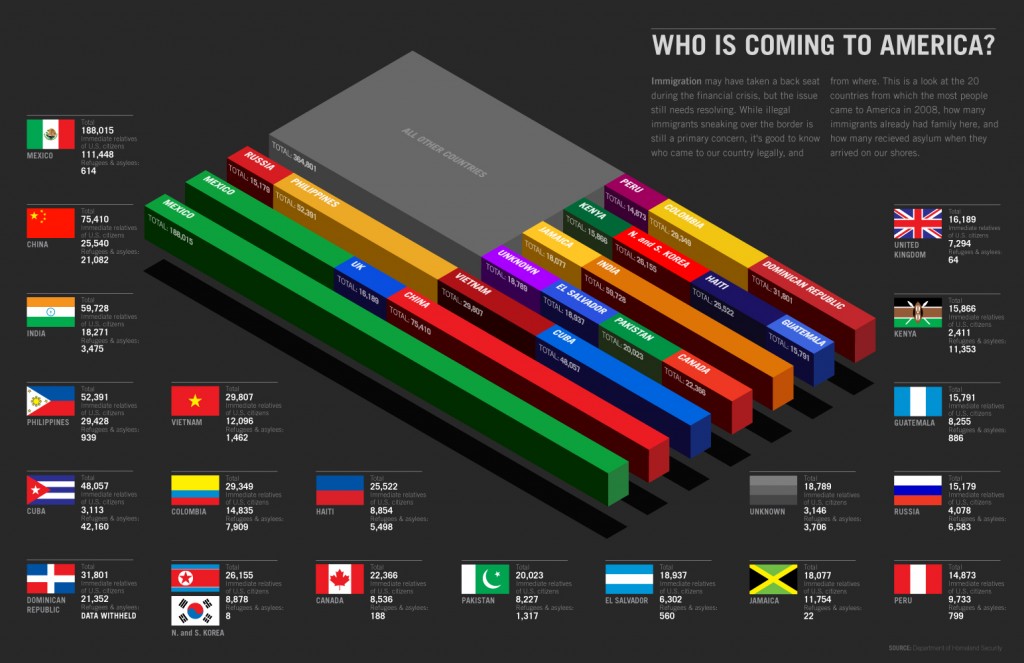From the folks at Good Magazine, a “look at the 20 countries from which the most people came to America in 2008,” including how many were immediate relatives of US citizens, and how many received asylum, based on data from the Department of Homeland Security.

Does anyone know why data from North Korea and South Korea is combined? How can country be “unknown” for so many?

Comments 8
David — May 6, 2009
I'd like to know how many come from each country as a part of human trafficing or against their will. It's a very interesting map, though.
Ole — May 6, 2009
Bah... they didn't count me in, I came from Sweden :(
Anyway. I added all the numbers for "refugee & asylee" (why doesn't this thing have a "total"?) and got the number 108,625.
A quick googling got me the information that the tiny little country (compared with the US) in 2004 registered 37,298 new asylum cases. I would have gotten more recent statistics but I just took the first one I could find:
http://www.migrationinformation.org/Profiles/display.cfm?ID=406 But let's say it's more or less the same numbers today.
So Sweden, which has a population of about 9 million people, took in one third of the number of refugees (in 2004) that the US, with a population of about 300 million people, took in (in 2008). Seems to me, that compared with other countries - and adjusting for the immense size of the US, the US hardly takes in any refugees at all?
Now, most of the immigration to the US is not refugee-based (but maybe a significant portion of the immigrants would be migrating as official refugees if it was possible?). The vast majority are non-refugees, whereas in (Northern) Europe the vast majority of immigrants are refugees or their relatives. Refugees made up half of the immigration to Sweden in 2004 - the total number of immigrants was 62,028 and some of the non-refugees were relatives of refugees.
Several of the biggest countries of origin for immigrants to the US are also heavily refugee-producing countries. And yet the US hardly grants asylum status to any refugees at all (as said: compared to a country like Sweden and adjusting for population sizes). This could indicate that several of the immigrants not classified as "refugees" come to the US for the same reasons as official refugees but either a) cannot get asylum because of restrictive US laws or b) don't feel the need to seek asylum because there are less restrictive (work based) immigration laws. This is unlike Europe where it is virtually impossible for (non-rich) people to get work-permits and permanent residency if they are from "refugee producing countries".
In any case, though, the US most likely faces the same "problem" as Europe: That the militarization of the borders to keep away un-regulated immigration also keeps away people who are actually refugees and thus have a legal right to enter (whether they seek official asylum status or not).
Ole — May 6, 2009
David,
Victims of human trafficking are not very likely to be in the official records of legal and regulated migration. So the answer would be: not many from either country. If by "against their will" you mean "forced migration" such as refugees then the answer is: probably way more than the numbers indicated in the map - as it would include a significant portion of those who are in the "normal" immigration category.
OuyangDan — May 6, 2009
It is extremely odd that the N and S Korea (DPRK and RoK, respectively) are combined, given that they are two extremely different countries w/ severely different cultures. I would say either those collecting the data are lazy, or don't realize that it isn't really useful to lump it like that. The purposes of migration would be vastly different for the two countries.
If I had to make a quasi educated guess, I would say that most of the small number of refugee/asylees come from DPRK, but it is hard to know for sure, since they are so closed off and knowing that it is nigh impossible to leave the country, not to mention extremely dangerous, as the borders on both side of the country are heavily guarded w/ military and land mines.
A good number of people in RoK have family in the US, and many still travel to the States for school or work. I would be interested in seeing it broken down more appropriately, by country, and further by purpose.
Huh. « random babble… — May 6, 2009
[...] Huh. By Ouyang Dan 0 Comments Categories: random babble Via Sociological Images: [...]
mercurianferret — May 6, 2009
Anyone know if the numbers for ROK/DPRK include adoptions to the US?
Dubi — May 6, 2009
What does it mean, refugees from Canada? Is it people who arrived as refugees there and moved on to the US? Cause I can't see how a Canadian citizen could ever style him- or herself as a refugee from this country (same goes for the UK).
Doc Haitien — May 9, 2009
one common complaint i have with images that have flags on them is why are their omissions. maybe this comes from my love of flags, but i notice that a lot of the nations represented have more to their flags than shown in this transparency.
the ones that i noticed:
haiti doesnt have its coat of arms in the middle like it does in its political flag like so: http://upload.wikimedia.org/wikipedia/commons/5/56/Flag_of_Haiti.svg
same with the dominican republic: http://upload.wikimedia.org/wikipedia/commons/thumb/9/9f/Flag_of_the_Dominican_Republic.svg/800px-Flag_of_the_Dominican_Republic.svg.png
el salvador (though an argument can be made that they're just using the variant flag): http://upload.wikimedia.org/wikipedia/commons/thumb/3/34/Flag_of_El_Salvador.svg/186px-Flag_of_El_Salvador.svg.png
guatemala (though it too has a variant flag): http://en.wikipedia.org/wiki/File:Flag_of_Guatemala.svg
it's jarring to me that people find it important to have things like the wheel on india's flag but the haiti's coat of arms isnt important enough to be put on display. that said i do like to see more haitians coming to the country